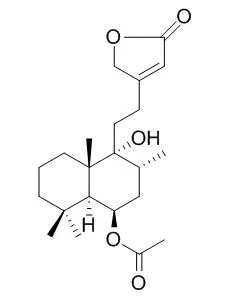| Kinase Assay: |
| Bioinformation, 2012, 8(24):1206-10. | | Virtual screening of Indonesian herbal database as HIV-1 reverse transcriptase inhibitor.[Pubmed: 23275721 ] | HIV-1 (Human immunodeficiency virus type 1) is a member of retrovirus family that could infect human and causing AIDS disease. AIDS epidemic is one of most destructive diseases in modern era.
METHODS AND RESULTS:
There were more than 33 million people infected by HIV until 2010. Various studies have been widely employed to design drugs that target the essential enzymes of HIV-1 that is, reverse transcriptase, protease and integrase. In this study, in silico virtual screening approach is used to find lead molecules from the library or database of natural compounds as HIV-1 reverse transcriptase inhibitor. Virtual screening against Indonesian Herbal Database using AutoDock4 performed on HIV-1 reverse transcriptase.
CONCLUSIONS:
From the virtual screening, top ten compounds were mulberrin, plucheoside A, Vitexilactone, brucine N-oxide, cyanidin 3-arabinoside, alpha-mangostin, guaijaverin, erycristagallin, morusin and sanggenol N. |
|
| Structure Identification: |
| J Chromatogr B Analyt Technol Biomed Life Sci. 2013 May 15;927:181-90. | | Development and validation of a rapid ultra-high performance liquid chromatography diode array detector method for Vitex agnus-castus.[Pubmed: 23522912] |
METHODS AND RESULTS:
A rapid ultra-high performance liquid chromatography diode array detector (UHPLC-DAD) method was developed and validated for the simultaneous determination of all classes of non-volatile phytochemicals (iridoids, flavonoids and diterpenes) in Vitex agnus-castus (Lamiaceae) fruits, a traditional medicinal plant used against premenstrual symptoms (PMS) and other disorders. Seven marker compounds, 3,4-dihydroxybenzoic acid, p-hydroxybenzoic acid, agnuside, 5-hydroxykaempferol-3,6,7,4'-tetramethylether, 1,2-dibenzoic acid glucose, methoxy-Vitexilactone, and vitetrifolin D were isolated from the methanol extract of V. agnus-castus to be used as reference substances. Chromatographic separation was performed on a Zorbax Eclipse XDB-C18 (50mm×2.1mm) UHPLC column with 1.8μm particle size, within 20min. A solvent gradient from 0.5% acetic acid to acetonitrile at a flow rate of 0.6mL/min was used as mobile phase. Analyte detection and quantification was realized at 210nm and 260nm. The UHPLC-DAD assay was validated for the quantitative analysis of agnuside, isovitexin, casticin, 5-hydroxykaempferol-3,6,7,4'-tetramethylether and vitetrifolin D. It was found to be specific, accurate, precise, and reproducible for the quantification of these compound within a concentration range of 0.7-500.0μg/mL for casticin and 5-hydroxykaempferol-3,6,7,4'-tetramethylether, 1.4-1000.0μg/mL for isovitexin and agnuside, and 12.4-1000.0μg/mL for vitetrifolin D. Intra- and inter-day variations showed relative standard deviations (RSD) of less than 3.9% and 6.4%, respectively. Tentatively assignment of 62 chromatographic features found in the UHPLC-DAD assay was carried out by coupling the UHPLC instrument to a quadrupole time-of-flight mass spectrometer via an electrospray ionization interface (ESI-QTOF-MS) operated in positive and negative ion mode.
CONCLUSIONS:
By using the established quantitative UHPLC-DAD assay to asses agnuside, isovitexin, casticin, 5-hydroxykaempferol-3,6,7,4'-tetramethylether and vitetrifolin D in V. agnus-castus derived preparations as extracts, tinctures and tablets, the applicability of the developed assay to phytopharmaceuticals was successfully proven. | | Evid Based Complement Alternat Med. 2013;2013:432829. | | Compounds from the Fruits of the Popular European Medicinal Plant Vitex agnus-castus in Chemoprevention via NADP(H):Quinone Oxidoreductase Type 1 Induction.[Pubmed: 23662135] | As part of our continuing efforts in the search for potential biologically active compounds from medicinal plants, we have isolated 18 compounds including two novel nitrogen containing diterpenes from extracts of the fruits of Vitex agnus-castus.
METHODS AND RESULTS:
These isolates, along with our previously obtained novel compound vitexlactam A (1), were evaluated for potential biological effects, including cancer chemoprevention. Chemically, the nitrogenous isolates were found to be two labdane diterpene alkaloids, each containing an α , β -unsaturated γ -lactam moiety. Structurally, they were elucidated to be 9 α -hydroxy-13(14)-labden-16,15-amide (2) and 6 β -acetoxy-9 α -hydroxy-13(14)-labden-15,16-amide (3), which were named vitexlactams B and C, respectively. The 15 known isolates were identified as Vitexilactone (4), rotundifuran (5), 8-epi-manoyl oxide (6), vitetrifolin D (7), spathulenol (8), cis-dihydro-dehydro-diconiferylalcohol-9-O- β -D-glucoside (9), luteolin-7-O-glucoside (10), 5-hydroxy-3,6,7,4'-tetramethoxyflavone (11), casticin (12), artemetin (13), aucubin (14), agnuside (15), β -sitosterol (16), p-hydroxybenzoic acid (17), and p-hydroxybenzoic acid glucose ester (18). All compound structures were determined/identified on the basis of 1D and/or 2D NMR and mass spectrometry techniques.
CONCLUSIONS:
Compounds 6, 8, 9, and 18 were reported from a Vitex spieces for the first time. The cancer chemopreventive potentials of these isolates were evaluated for NADP(H):quinone oxidoreductase type 1 (QR1) induction activity. Compound 7 demonstrated promising QR1 induction effect, while the new compound vitexlactam (3) was only slightly active. |
|






 Cell. 2018 Jan 11;172(1-2):249-261.e12. doi: 10.1016/j.cell.2017.12.019.IF=36.216(2019)
Cell. 2018 Jan 11;172(1-2):249-261.e12. doi: 10.1016/j.cell.2017.12.019.IF=36.216(2019) Cell Metab. 2020 Mar 3;31(3):534-548.e5. doi: 10.1016/j.cmet.2020.01.002.IF=22.415(2019)
Cell Metab. 2020 Mar 3;31(3):534-548.e5. doi: 10.1016/j.cmet.2020.01.002.IF=22.415(2019) Mol Cell. 2017 Nov 16;68(4):673-685.e6. doi: 10.1016/j.molcel.2017.10.022.IF=14.548(2019)
Mol Cell. 2017 Nov 16;68(4):673-685.e6. doi: 10.1016/j.molcel.2017.10.022.IF=14.548(2019)